Tao Wei
Ant Group
AnchorSync: Global Consistency Optimization for Long Video Editing
Aug 20, 2025Abstract:Editing long videos remains a challenging task due to the need for maintaining both global consistency and temporal coherence across thousands of frames. Existing methods often suffer from structural drift or temporal artifacts, particularly in minute-long sequences. We introduce AnchorSync, a novel diffusion-based framework that enables high-quality, long-term video editing by decoupling the task into sparse anchor frame editing and smooth intermediate frame interpolation. Our approach enforces structural consistency through a progressive denoising process and preserves temporal dynamics via multimodal guidance. Extensive experiments show that AnchorSync produces coherent, high-fidelity edits, surpassing prior methods in visual quality and temporal stability.
COPO: Consistency-Aware Policy Optimization
Aug 06, 2025Abstract:Reinforcement learning has significantly enhanced the reasoning capabilities of Large Language Models (LLMs) in complex problem-solving tasks. Recently, the introduction of DeepSeek R1 has inspired a surge of interest in leveraging rule-based rewards as a low-cost alternative for computing advantage functions and guiding policy optimization. However, a common challenge observed across many replication and extension efforts is that when multiple sampled responses under a single prompt converge to identical outcomes, whether correct or incorrect, the group-based advantage degenerates to zero. This leads to vanishing gradients and renders the corresponding samples ineffective for learning, ultimately limiting training efficiency and downstream performance. To address this issue, we propose a consistency-aware policy optimization framework that introduces a structured global reward based on outcome consistency, the global loss based on it ensures that, even when model outputs show high intra-group consistency, the training process still receives meaningful learning signals, which encourages the generation of correct and self-consistent reasoning paths from a global perspective. Furthermore, we incorporate an entropy-based soft blending mechanism that adaptively balances local advantage estimation with global optimization, enabling dynamic transitions between exploration and convergence throughout training. Our method introduces several key innovations in both reward design and optimization strategy. We validate its effectiveness through substantial performance gains on multiple mathematical reasoning benchmarks, highlighting the proposed framework's robustness and general applicability. Code of this work has been released at https://github.com/hijih/copo-code.git.
VeFIA: An Efficient Inference Auditing Framework for Vertical Federated Collaborative Software
Jul 03, 2025



Abstract:Vertical Federated Learning (VFL) is a distributed AI software deployment mechanism for cross-silo collaboration without accessing participants' data. However, existing VFL work lacks a mechanism to audit the execution correctness of the inference software of the data party. To address this problem, we design a Vertical Federated Inference Auditing (VeFIA) framework. VeFIA helps the task party to audit whether the data party's inference software is executed as expected during large-scale inference without leaking the data privacy of the data party or introducing additional latency to the inference system. The core of VeFIA is that the task party can use the inference results from a framework with Trusted Execution Environments (TEE) and the coordinator to validate the correctness of the data party's computation results. VeFIA guarantees that, as long as the abnormal inference exceeds 5.4%, the task party can detect execution anomalies in the inference software with a probability of 99.99%, without incurring any additional online inference latency. VeFIA's random sampling validation achieves 100% positive predictive value, negative predictive value, and true positive rate in detecting abnormal inference. To the best of our knowledge, this is the first paper to discuss the correctness of inference software execution in VFL.
Losing is for Cherishing: Data Valuation Based on Machine Unlearning and Shapley Value
May 22, 2025Abstract:The proliferation of large models has intensified the need for efficient data valuation methods to quantify the contribution of individual data providers. Traditional approaches, such as game-theory-based Shapley value and influence-function-based techniques, face prohibitive computational costs or require access to full data and model training details, making them hardly achieve partial data valuation. To address this, we propose Unlearning Shapley, a novel framework that leverages machine unlearning to estimate data values efficiently. By unlearning target data from a pretrained model and measuring performance shifts on a reachable test set, our method computes Shapley values via Monte Carlo sampling, avoiding retraining and eliminating dependence on full data. Crucially, Unlearning Shapley supports both full and partial data valuation, making it scalable for large models (e.g., LLMs) and practical for data markets. Experiments on benchmark datasets and large-scale text corpora demonstrate that our approach matches the accuracy of state-of-the-art methods while reducing computational overhead by orders of magnitude. Further analysis confirms a strong correlation between estimated values and the true impact of data subsets, validating its reliability in real-world scenarios. This work bridges the gap between data valuation theory and practical deployment, offering a scalable, privacy-compliant solution for modern AI ecosystems.
Growing a Twig to Accelerate Large Vision-Language Models
Mar 18, 2025Abstract:Large vision-language models (VLMs) have demonstrated remarkable capabilities in open-world multimodal understanding, yet their high computational overheads pose great challenges for practical deployment. Some recent works have proposed methods to accelerate VLMs by pruning redundant visual tokens guided by the attention maps of VLM's early layers. Despite the success of these token pruning methods, they still suffer from two major shortcomings: (i) considerable accuracy drop due to insensitive attention signals in early layers, and (ii) limited speedup when generating long responses (e.g., 30 tokens). To address the limitations above, we present TwigVLM -- a simple and general architecture by growing a lightweight twig upon an early layer of the base VLM. Compared with most existing VLM acceleration methods purely based on visual token pruning, our TwigVLM not only achieves better accuracy retention by employing a twig-guided token pruning (TTP) strategy, but also yields higher generation speed by utilizing a self-speculative decoding (SSD) strategy. Taking LLaVA-1.5-7B as the base VLM, experimental results show that TwigVLM preserves 96% of the original performance after pruning 88.9% of visual tokens and achieves 154% speedup in generating long responses, delivering significantly better performance in terms of both accuracy and speed over the state-of-the-art VLM acceleration methods. Code will be made publicly available.
LDGen: Enhancing Text-to-Image Synthesis via Large Language Model-Driven Language Representation
Feb 25, 2025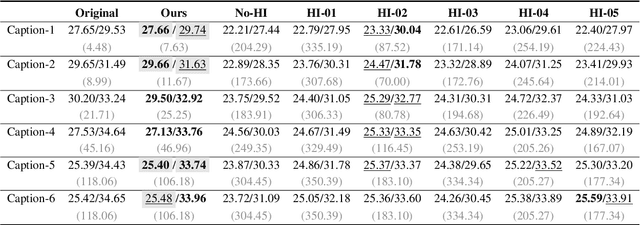
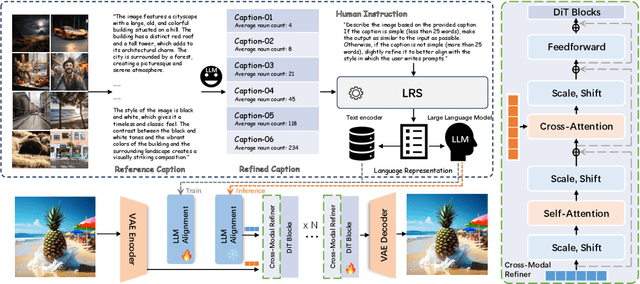
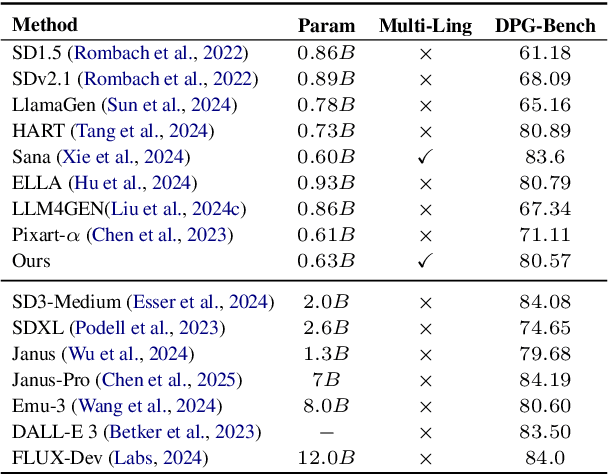

Abstract:In this paper, we introduce LDGen, a novel method for integrating large language models (LLMs) into existing text-to-image diffusion models while minimizing computational demands. Traditional text encoders, such as CLIP and T5, exhibit limitations in multilingual processing, hindering image generation across diverse languages. We address these challenges by leveraging the advanced capabilities of LLMs. Our approach employs a language representation strategy that applies hierarchical caption optimization and human instruction techniques to derive precise semantic information,. Subsequently, we incorporate a lightweight adapter and a cross-modal refiner to facilitate efficient feature alignment and interaction between LLMs and image features. LDGen reduces training time and enables zero-shot multilingual image generation. Experimental results indicate that our method surpasses baseline models in both prompt adherence and image aesthetic quality, while seamlessly supporting multiple languages. Project page: https://zrealli.github.io/LDGen.
PRIV-QA: Privacy-Preserving Question Answering for Cloud Large Language Models
Feb 19, 2025Abstract:The rapid development of large language models (LLMs) is redefining the landscape of human-computer interaction, and their integration into various user-service applications is becoming increasingly prevalent. However, transmitting user data to cloud-based LLMs presents significant risks of data breaches and unauthorized access to personal identification information. In this paper, we propose a privacy preservation pipeline for protecting privacy and sensitive information during interactions between users and LLMs in practical LLM usage scenarios. We construct SensitiveQA, the first privacy open-ended question-answering dataset. It comprises 57k interactions in Chinese and English, encompassing a diverse range of user-sensitive information within the conversations. Our proposed solution employs a multi-stage strategy aimed at preemptively securing user information while simultaneously preserving the response quality of cloud-based LLMs. Experimental validation underscores our method's efficacy in balancing privacy protection with maintaining robust interaction quality. The code and dataset are available at https://github.com/ligw1998/PRIV-QA.
Self-Enhanced Reasoning Training: Activating Latent Reasoning in Small Models for Enhanced Reasoning Distillation
Feb 18, 2025Abstract:The rapid advancement of large language models (LLMs) has significantly enhanced their reasoning abilities, enabling increasingly complex tasks. However, these capabilities often diminish in smaller, more computationally efficient models like GPT-2. Recent research shows that reasoning distillation can help small models acquire reasoning capabilities, but most existing methods focus primarily on improving teacher-generated reasoning paths. Our observations reveal that small models can generate high-quality reasoning paths during sampling, even without chain-of-thought prompting, though these paths are often latent due to their low probability under standard decoding strategies. To address this, we propose Self-Enhanced Reasoning Training (SERT), which activates and leverages latent reasoning capabilities in small models through self-training on filtered, self-generated reasoning paths under zero-shot conditions. Experiments using OpenAI's GPT-3.5 as the teacher model and GPT-2 models as the student models demonstrate that SERT enhances the reasoning abilities of small models, improving their performance in reasoning distillation.
RACONTEUR: A Knowledgeable, Insightful, and Portable LLM-Powered Shell Command Explainer
Sep 03, 2024



Abstract:Malicious shell commands are linchpins to many cyber-attacks, but may not be easy to understand by security analysts due to complicated and often disguised code structures. Advances in large language models (LLMs) have unlocked the possibility of generating understandable explanations for shell commands. However, existing general-purpose LLMs suffer from a lack of expert knowledge and a tendency to hallucinate in the task of shell command explanation. In this paper, we present Raconteur, a knowledgeable, expressive and portable shell command explainer powered by LLM. Raconteur is infused with professional knowledge to provide comprehensive explanations on shell commands, including not only what the command does (i.e., behavior) but also why the command does it (i.e., purpose). To shed light on the high-level intent of the command, we also translate the natural-language-based explanation into standard technique & tactic defined by MITRE ATT&CK, the worldwide knowledge base of cybersecurity. To enable Raconteur to explain unseen private commands, we further develop a documentation retriever to obtain relevant information from complementary documentations to assist the explanation process. We have created a large-scale dataset for training and conducted extensive experiments to evaluate the capability of Raconteur in shell command explanation. The experiments verify that Raconteur is able to provide high-quality explanations and in-depth insight of the intent of the command.
A Single-Step Non-Autoregressive Automatic Speech Recognition Architecture with High Accuracy and Inference Speed
Jun 13, 2024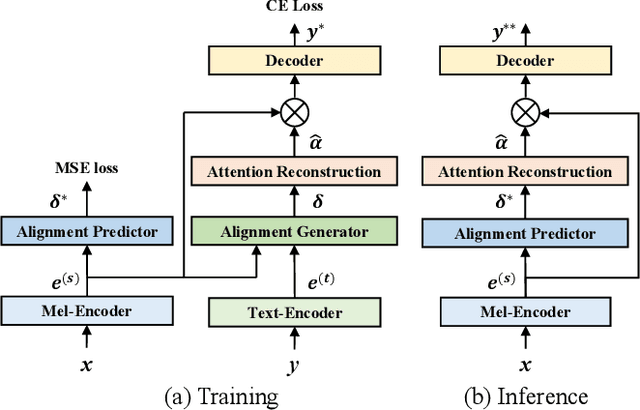
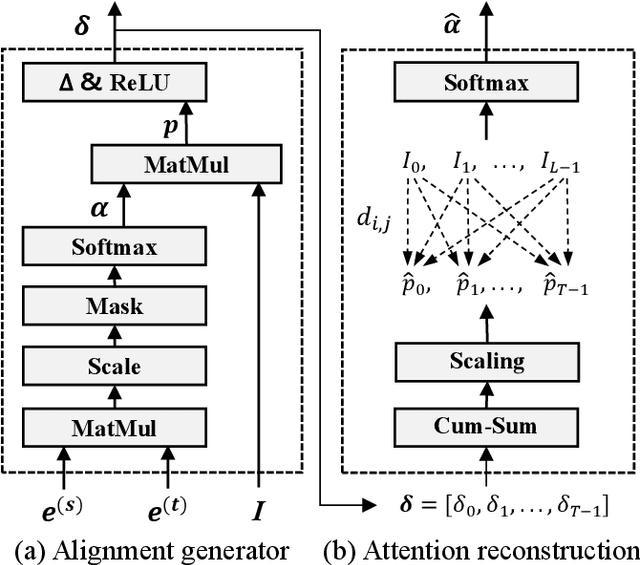
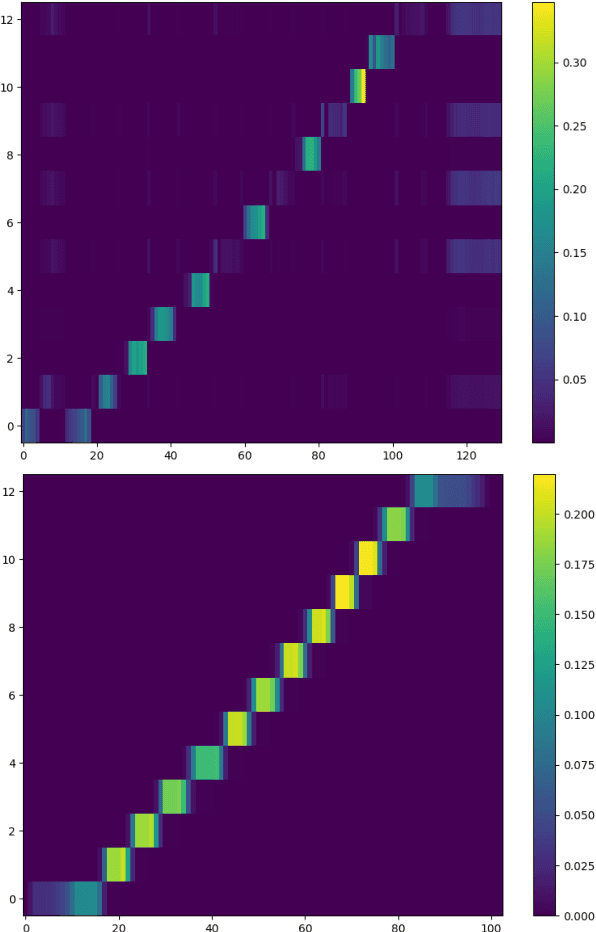
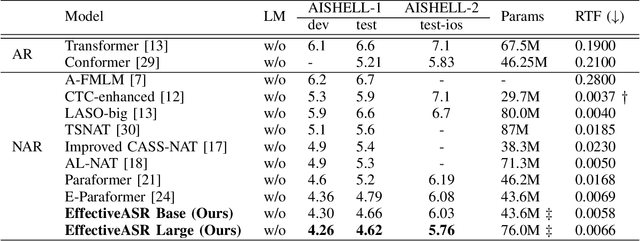
Abstract:Non-autoregressive (NAR) automatic speech recognition (ASR) models predict tokens independently and simultaneously, bringing high inference speed. However, there is still a gap in the accuracy of the NAR models compared to the autoregressive (AR) models. To further narrow the gap between the NAR and AR models, we propose a single-step NAR ASR architecture with high accuracy and inference speed, called EfficientASR. It uses an Index Mapping Vector (IMV) based alignment generator to generate alignments during training, and an alignment predictor to learn the alignments for inference. It can be trained end-to-end (E2E) with cross-entropy loss combined with alignment loss. The proposed EfficientASR achieves competitive results on the AISHELL-1 and AISHELL-2 benchmarks compared to the state-of-the-art (SOTA) models. Specifically, it achieves character error rates (CER) of 4.26%/4.62% on the AISHELL-1 dev/test dataset, which outperforms the SOTA AR Conformer with about 30x inference speedup.
 Add to Chrome
Add to Chrome Add to Firefox
Add to Firefox Add to Edge
Add to Edge